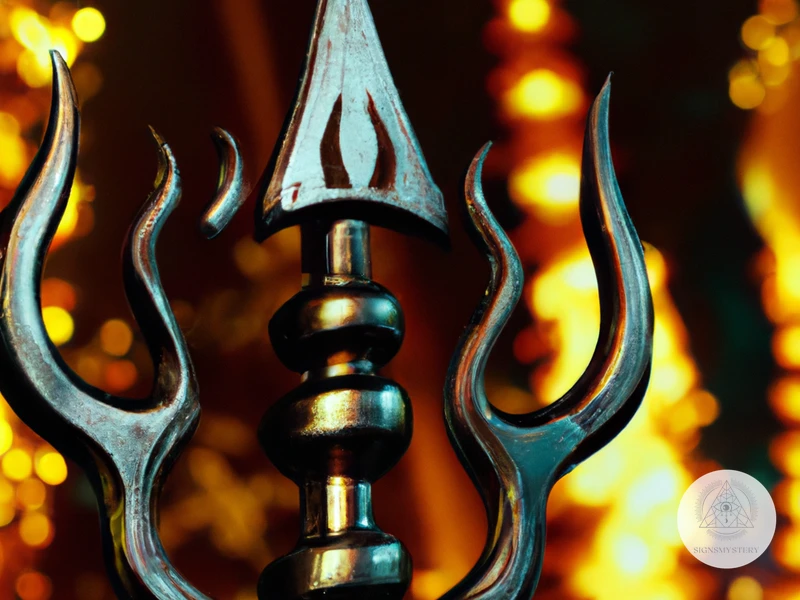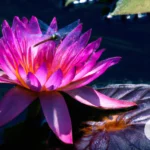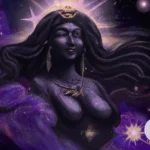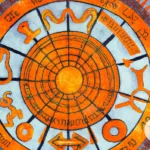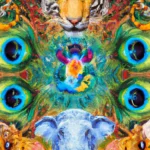Exploring the Symbolism Behind the Trishula in Hinduism can be a fascinating journey that unveils the depths of the Hindu culture and mythology. The Trishula, also known as the trident, is a symbolic weapon associated with Lord Shiva, one of the most revered deities in Hinduism. However, its symbolism goes beyond its association with Lord Shiva, as it embodies powerful meanings that have come to define the Hindu religion and culture. In this article, we will delve into the physical description, history, and symbolism of the Trishula, as well as its uses in religious ceremonies, art, and modern culture. Join us as we unravel the mysteries behind this sacred weapon and explore the richness of Hindu symbolism.
What is the Trishula?
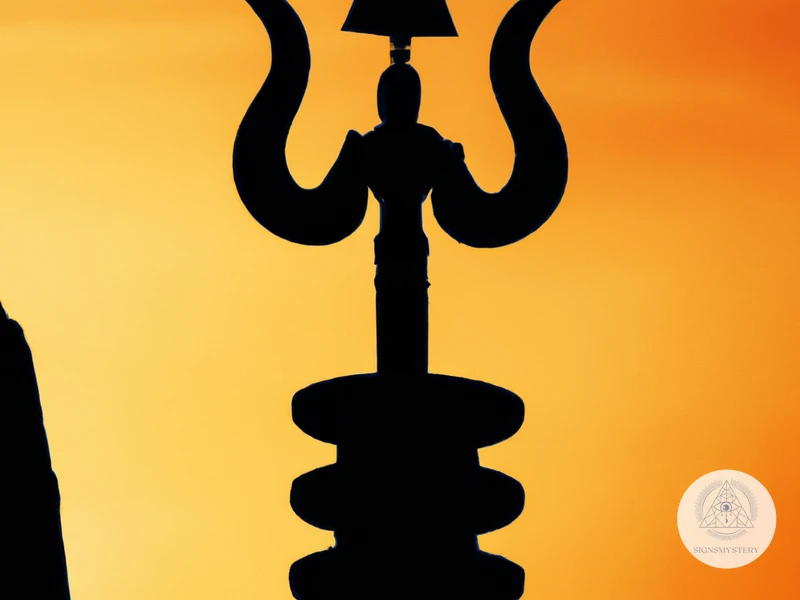
The Trishula is an ancient symbol in Hinduism that holds great significance. Its name is derived from the Sanskrit words “tri” meaning “three” and “shula” meaning “spear”. The Trishula is characterized by its three pointed design and is often depicted being held by the Hindu deity Shiva. It symbolizes many aspects of Hinduism, including the three gunas of nature, the three aspects of the divine, and the three states of consciousness. The Trishula is still widely used in modern Hindu culture and its symbolism can be found in various religious ceremonies and artworks. This symbol, like many other symbols in Hinduism such as the Om and the lotus, holds a deep cultural and spiritual meaning that has been passed down through generations.
The Physical Description of the Trishula
The Trishula is a powerful symbol in Hinduism that holds a great deal of meaning. The word “trishula” itself comes from the Sanskrit language and it means “three pointed”. As its name suggests, the Trishula consists of three points that are arranged in a certain way to create its distinctive shape.
The Trishula is usually made of metal and has a long handle with three prongs at the end. Each of these prongs is pointed and sharp, giving the weapon a fearsome appearance. Despite its sharpness, the Trishula is not primarily used as a weapon in Hinduism, but rather as a symbol of power and protection.
The physical description of the Trishula is striking and distinctive, with each of its three points symbolizing something important. The first prong represents Lord Shiva, who is one of the most important gods in Hinduism. The second prong is said to represent Lord Vishnu, who is also a powerful and revered figure in Hindu mythology. Finally, the third prong is believed to represent Lord Brahma, who is the creator of the universe according to Hindu belief.
The handle of the Trishula is also important and is often decorated with intricate patterns and designs that hold significance in Hinduism. The handle represents balance and stability, two important qualities that are valued in both Hinduism and in the use of the Trishula.
The physical appearance of the Trishula is striking and symbolic. Its shape and design are meant to represent important ideas and beliefs within Hinduism, and its use in religious ceremonies and rituals underscores its power and significance. It is an important symbol that continues to hold meaning and importance in modern Hindu culture.
Related:
- Om Symbol in Hinduism: Meaning and Significance Explained
- The Lotus Symbolism in Hinduism
- The Swastika: Its History and Significance in Hinduism
History of the Trishula
The history of the Trishula dates back to ancient times in India. The exact origin of the Trishula is uncertain, but it is believed to have been used even before the Vedic period. The trident was first mentioned in the Rigveda, one of the oldest Hindu texts, as the weapon of Lord Shiva.
Throughout history, the Trishula has been used as both a weapon and a symbol of power. It was often carried by warriors and kings as a sign of their authority. The Trishula also became a popular symbol in Shaivism, one of the major branches of Hinduism that worships Lord Shiva.
According to legend, the Trishula was created by Lord Shiva himself. The three prongs of the Trishula are said to represent the three aspects of existence – creation, preservation, and destruction. Lord Shiva’s use of the Trishula in battles not only signifies his power but also his ability to maintain the balance of the universe.
Throughout history, the Trishula has been associated with various Hindu deities and mythological stories. Goddess Durga is often depicted with a Trishula in her hand, representing her power and ability to destroy evil. Lord Vishnu’s Trishula is believed to represent his power to control the three gunas – Sattva, Rajas, and Tamas.
In addition to its use in Hinduism, the Trishula has also been used in Buddhism, where it represents the Three Jewels of Buddhism – the Buddha, the Dharma, and the Sangha. The Trishula has also been adopted by many other cultures and religions, including Jainism and Sikhism.
The Trishula has had a rich and complex history, and its symbolism and significance continue to be deeply ingrained in Hindu culture. The continued use of this powerful symbol is a testament to its enduring relevance and significance.
The Symbolism of the Trishula
The Trishula holds significant symbolism in Hinduism. The three points of the Trishula represent three key aspects of life: creation, sustenance, and destruction. Brahma, the creator, is associated with the first point, Vishnu, the preserver, with the second point, and Shiva, the destroyer, with the third point. The Trishula also symbolizes the three states of consciousness: waking, dreaming, and deep sleep. Additionally, the Trishula represents the three gunas or qualities: sattva (purity), rajas (activity), and tamas (inertia). It is a powerful symbol that incorporates multiple layers of meaning and serves as a reminder of the complex nature of existence.
The Three Points of the Trishula
The Trishula, also known as the trident, is a powerful Hindu symbol that is able to represent various meanings. The Trishula features three points or prongs and each of these points are symbolic in their own right. Here is a closer look at each of these three points:
| The First Point of the Trishula | The Second Point of the Trishula | The Third Point of the Trishula |
|---|---|---|
| The first point of the trishula is believed to represent the Creator of the universe, Lord Brahma. It is also said to be symbolic of the qualities of sattva (purity) and rajas (passion). | The second point of the trishula represents Lord Vishnu, who is responsible for preserving the universe. It is also symbolic of the quality of sattva. | The third point symbolizes Lord Shiva, the destroyer of the universe. It is also symbolic of the quality of tamas (inertia). |
Together, these three points are said to represent the three aspects of existence – creation, preservation, and destruction. They also represent the triple qualities of nature – sattva, rajas, and tamas. The Trishula is believed to represent the power and unity of these three aspects of existence and nature. It is also believed that the Trishula can be used to balance these qualities within oneself, leading to spiritual enlightenment.
The Deities Associated with the Trishula
The Trishula is deeply associated with various Hindu deities who wield this powerful weapon. Below are some of the major deities that are linked with the Trishula and why:
| Deity | Significance |
|---|---|
| Lord Shiva | Lord Shiva, also known as the destroyer, is perhaps the most widely associated deity with the Trishula. According to Hindu mythology, the Trishula was created by Lord Shiva himself as a weapon to defeat evil demon Tripura. It is also believed that Lord Shiva uses the Trishula to destroy ignorance, evil, and negativity in the world. |
| Goddess Durga | Goddess Durga, the divine mother, is also seen holding the Trishula in many depictions. It is believed that the Trishula represents the three characteristics of Durga: creation, preservation, and destruction. |
| Goddess Kali | Goddess Kali is a fierce and powerful deity who wields the Trishula as a symbol of her strength and ability to destroy evil. It is believed that the Trishula in Kali’s hand represents the three gunas or qualities of nature: tamas (darkness), rajas (passion), and sattva (purity). |
| Lord Vishnu | Although Lord Vishnu is not often depicted with the Trishula, there are some references to his use of the weapon. In Hindu mythology, it is said that Lord Vishnu used the Trishula to kill demon Madhu, who was threatening the balance of the universe. |
These deities and their association with the Trishula highlight the powerful symbolism and significance of this weapon in Hinduism. Whether it represents destruction, creation, or balance, the Trishula remains a potent reminder of the power of the divine in Hindu culture.
The Trishula in Hindu Mythology
The Trishula, or trident, holds a significant role in the mythology of Hinduism. In Hindu mythology, the trident is primarily associated with Lord Shiva, one of the primary deities in Hinduism. Here are some of the main myths surrounding the Trishula in Hindu mythology:
The Trishula as a Weapon of Lord Shiva
According to Hindu mythology, Lord Shiva is known for wielding the Trishula as one of his primary weapons. Legend has it that he uses the trident to destroy evil and ignorance, and to ultimately create balance in the universe. The three points of the Trishula are said to symbolize the three main aspects of creation, preservation, and destruction, which Lord Brahma, Lord Vishnu, and Lord Shiva respectively represent.
The Trishula and the Story of Ganga
Another prominent myth associated with the Trishula is the story of Lord Shiva and Ganga, the river goddess. According to the myth, Ganga was descended from heaven to purify the ashes of the ancestors of Lord Shiva. However, the strength of the descending river was too much for the earth to handle, and it was believed that it would lead to catastrophic destruction. To avoid this calamity, Lord Shiva caught Ganga in his Trishula, breaking it up into several smaller streams, which were then dispersed into various regions of the earth.
The Trishula and the Demons
The Trishula is also known to be a powerful weapon against demons and evil forces. In Hindu mythology, there are several demon-slaying stories where the Trishula plays a key role. In one such story, Lord Shiva used the trident to defeat the demon Andhaka, who had taken control of the universe. In another story, Lord Shiva defeated the demon Tripura, who had become arrogant and refused to acknowledge Lord Shiva’s superiority.
The Trishula holds a significant place in Hindu mythology, particularly in association with Lord Shiva. It is revered as a symbol of power and destruction but also has a deeper spiritual meaning as a symbol of balance and creation. Its importance in Hindu mythology is reflected in its continued use in religious ceremonies and in modern culture.
Uses of the Trishula
The Trishula is a significant symbol in Hinduism and holds a lot of importance in religious ceremonies and rituals. In ancient times, the Trishula was commonly used as a weapon of defense and offense in battles. Today, it is still used in certain martial art forms and is a symbol of protection and power. Additionally, the Trishula is often seen in Hindu art, as a decorative element in sculptures and paintings. In religious
Subscribe to Our Newsletter
Sign up to receive the latest news and updates.
The Trishula in Religious Ceremonies
One of the most significant uses of the Trishula is in religious ceremonies in Hinduism. The Trishula holds immense spiritual significance and is often used as a symbol to ward off evil. Here are some ways in which the Trishula is used in religious ceremonies:
- Puja: The Trishula is an essential element in the puja (ritual worship) of Lord Shiva. During the puja, the Trishula is used to offer prayers and chant mantras.
- Meditation: Many Hindus meditate holding the Trishula. It is believed that holding the Trishula during meditation helps in focusing on the divine energy and invoking the blessings of Lord Shiva.
- Blessings: In many religious ceremonies, the Trishula is used to bless the devotees. The Trishula is dipped in holy water and is used to sprinkle blessings on the devotees.
- Processions: The Trishula is carried in grand processions during Maha Shivaratri and other festivals. Devotees carry the Trishula with great reverence and perform aarti (lighting of lamps) in front of it.
The Trishula is often adorned with flowers and other offerings during these ceremonies, making it an essential element in Hindu worship. The Trishula’s religious significance is said to be so powerful that it is believed that even a glimpse of it can grant great blessings to the devotee. The next time you see the Trishula in a religious ceremony, take a moment to appreciate its deep spiritual significance and the role it plays in Hindu worship.
The Trishula in Hindu Art
The Trishula has been a popular and recurring symbol in Hindu art for centuries and can be seen in various forms, from paintings and sculptures to jewelry and clothing. It has been depicted in different styles and designs, but its three-pronged shape remains a constant element.
Here are some examples of the Trishula in Hindu art:
| Artwork/Artifact | Description |
|---|---|
| Paintings |
|
| Sculptures |
|
| Jewelry and Clothing |
|
The Trishula is not only revered for its spiritual significance but also for its aesthetic value. Its elegant and powerful shape has made it a favorite among artists and designers, who continue to incorporate it in their works to this day.
The Trishula in Modern Culture
The Trishula has come to represent various aspects of modern Indian culture and society. In recent years, its significance has expanded beyond religion and spirituality, and it has become a symbol of identity for many Indians. Here are some examples of how the Trishula is used in modern culture:
1. Indian Politics: The Trishula has been adopted as a political symbol by some Indian political parties. The Bharatiya Janata Party (BJP), for example, uses the Trishula as its party symbol. The party claims that the three points of the Trishula represent the three basic principles of its ideology: nationalism, democracy, and cultural identity.
2. Fashion and Accessories: The Trishula has also found a place in the Indian fashion industry. It is often used in jewelry, clothing, and accessories, especially for those who want to express their Indian identity or spirituality. The Trishula is believed to give its wearer strength, power, and protection.
3. Sports: The Trishula has even made its way into the world of sports. In 2010, the Indian Premier League (IPL) introduced a new team, the Deccan Chargers, whose logo featured the Trishula. The team’s name and logo were meant to represent the power and strength of the people of the Deccan region of India.
4. Tattoos: Tattoo enthusiasts around the world have also adopted the Trishula as a popular tattoo design. Some people get the Trishula tattooed on their bodies as a symbol of their connection to Indian culture, while others appreciate the deeper spiritual meanings of the symbol.
5. Festivals and Events: The Trishula is often seen at various festivals and events in India. It is sometimes used as a decorative element or as a prop in cultural performances. For example, during the annual Durga Puja festival in Kolkata, large Trishulas made of bamboo and colored paper are often erected as part of the decorations.
The Trishula has become an important symbol in modern Indian culture, representing strength, power, and spirituality. It has been adopted by various aspects of Indian society, including politics, fashion, sports, tattoos, and festivals. Its enduring popularity speaks to the deep cultural significance of this powerful symbol.
Conclusion
In conclusion, the Trishula holds immense significance in Hinduism and has various meanings and interpretations attached to it. With its three points, the Trishula stands for balance, harmony, and the destruction of negative forces.
The Trishula also embodies the power of three important Hindu deities – Brahma, Vishnu, and Shiva. Its presence in various religious ceremonies and pujas is a testament to its importance in Hindu culture.
Moreover, the Trishula has been depicted in Hindu art for centuries and continues to inspire modern art forms. Its intricate design and symbolism have influenced various creative fields, including fashion, home decor, and architecture.
The Trishula, with its rich history and multi-dimensional significance, is an embodiment of Hinduism’s complexity and depth. Its relevance has only grown over the years, and it remains a powerful symbol of Hindu culture and spirituality.
In conclusion, the Trishula is more than just a weapon or a symbol of power – it represents the very essence of Hinduism and its core beliefs. Its three points symbolize the balance of the physical, spiritual, and emotional realms, while its association with important Hindu deities makes it a revered symbol. The Trishula has found its way into various facets of life, from religious ceremonies to modern art and design, and its significance continues to be celebrated worldwide.
Frequently Asked Questions
What does the Trishula symbolize?
The Trishula symbolizes the power, strength, and overcoming of obstacles.
What does the Trishula physically look like?
The Trishula is a trident with three sharp points and is often decorated with ornate designs and symbols.
What is the history of the Trishula?
The Trishula has ancient origins and has been used as a weapon by Hindu gods and goddesses, as well as by the mortal warriors of India.
What are the three points of the Trishula?
The three points of the Trishula symbolize the creation, maintenance, and destruction of the universe.
Which deities are associated with the Trishula?
The Trishula is often associated with Lord Shiva, Goddess Durga, and Lord Vishnu, among other deities.
What is the significance of the Trishula in Hindu mythology?
In Hindu mythology, the Trishula is believed to be a powerful weapon that is capable of destroying negative energy and evil forces.
What are the uses of the Trishula in religious ceremonies?
The Trishula is often used to mark sacred spaces, bless devotees, and ward off negative energies during religious ceremonies.
What is the role of the Trishula in Hindu art?
The Trishula is a common motif in Hindu art, and is often depicted in paintings, sculptures, and other forms of art as a symbol of power and protection.
Is the Trishula still relevant in modern culture?
Yes, the Trishula is still a revered symbol in modern Hindu culture, and is often used in jewelry, clothing, and other forms of art and decoration.
What is the significance of the Trishula for modern Hindus?
For modern Hindus, the Trishula represents a connection to their cultural and religious heritage, as well as a symbol of strength, protection, and overcoming of obstacles.

